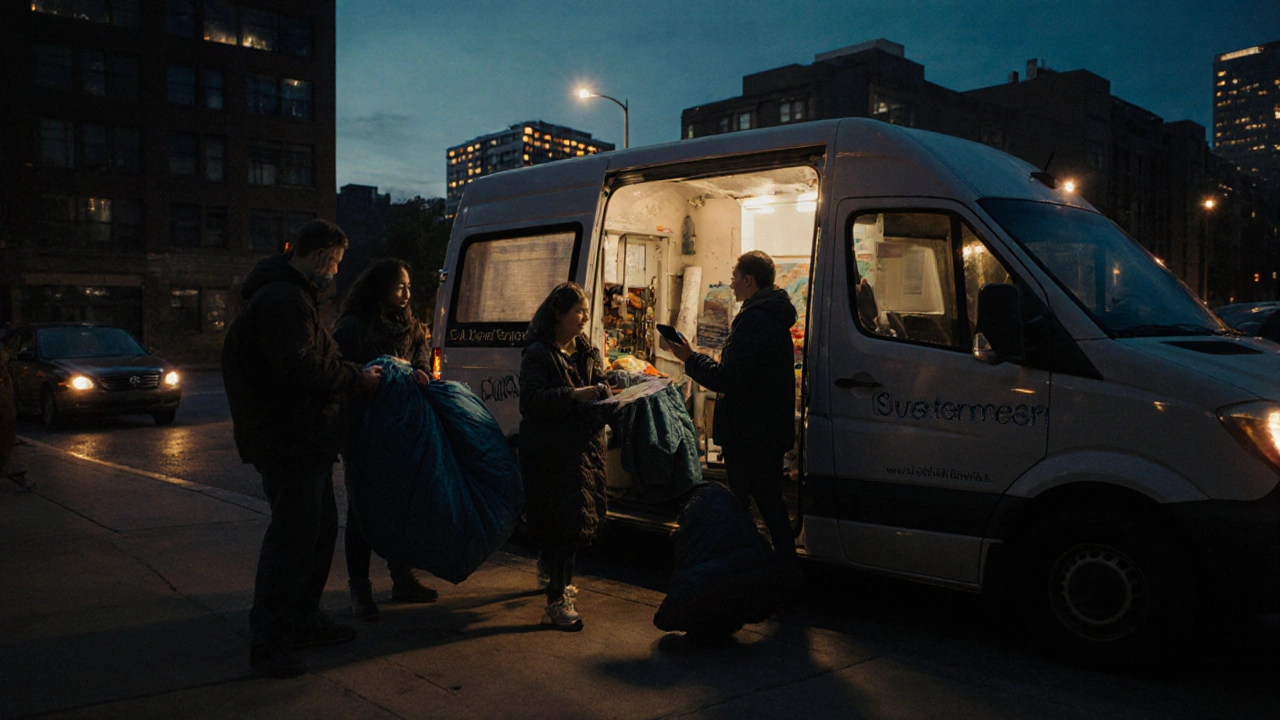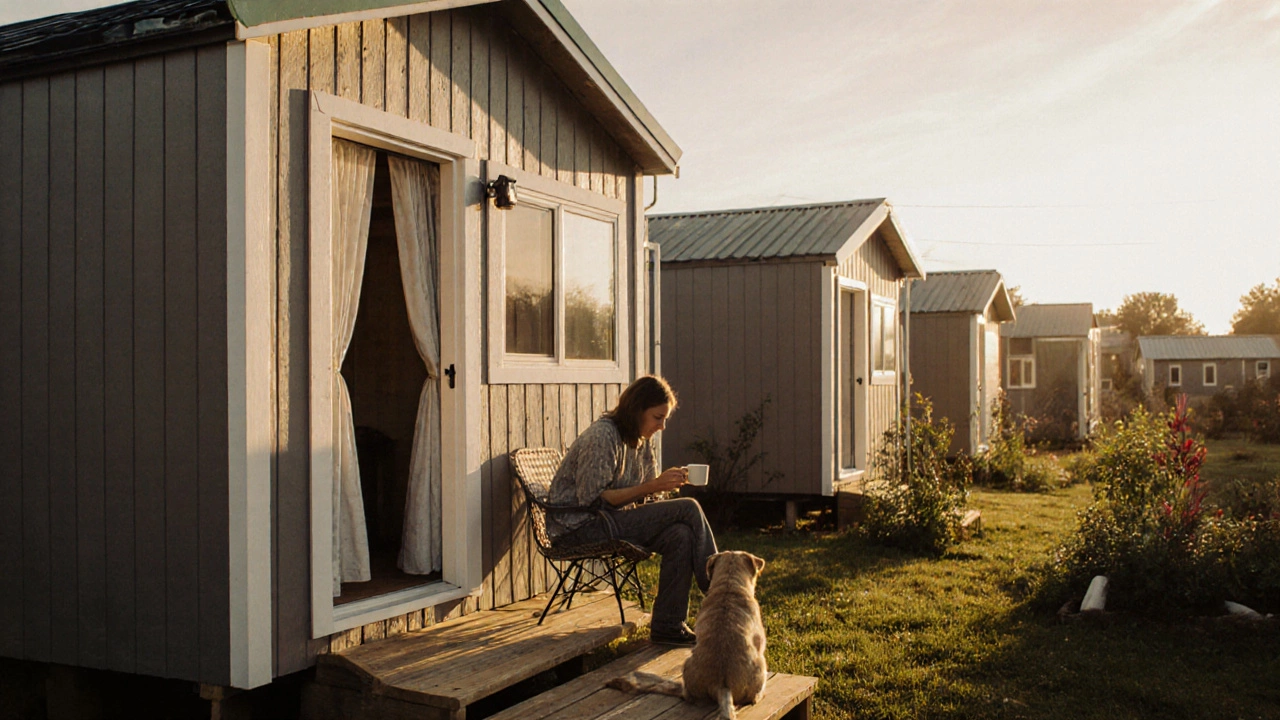Shelter Finder: Find Help Near You
Where Are You Now?
What Do You Need?
Why This Matters
Not all shelters are equal: The best places provide safety, services, and pathways to permanent housing. According to housing authorities, shelters with on-site case management help up to 40% of clients move into stable housing within six months.
Look for these key features:
- Safe storage for belongings
- Access to showers, laundry, and hygiene kits
- Staff trained in trauma-informed care
- Partnerships with local housing agencies
Shelters Near You
Enter your location and select needs to see available shelters
Get Immediate Help
Call 211 or visit 211.org for free, confidential assistance available 24/7 in every state.
Use the HUD Shelter Finder tool: hud.gov/shelter
If you’re homeless right now, the question isn’t just where to go-it’s where you can get safe, reliable help that actually lasts. Not every shelter is the same. Some are overcrowded. Some have strict rules that push people away. Others offer real pathways out of homelessness. Knowing the difference can change everything.
What Makes a Shelter Actually Helpful?
A good shelter isn’t just a bed and a meal. It’s a starting point. The best places combine safety, structure, and services. They don’t just house you-they connect you to case managers, mental health counselors, job training, and housing programs. In cities like Portland, Austin, and Seattle, shelters that offer on-site case management see up to 40% of clients move into stable housing within six months, according to local housing authority data. That’s not luck. It’s design.
Look for shelters that:
- Have no curfew or allow overnight stays without forced check-ins
- Offer storage for your belongings
- Provide access to showers, laundry, and hygiene kits
- Have staff trained in trauma-informed care
- Partner with local housing agencies
Shelters that don’t do these things may keep you dry for a night-but they won’t help you get off the streets for good.
Best Cities for Homeless Support in 2025
Not all cities treat homelessness the same way. Some treat it like a crisis to manage. Others treat it like a solvable problem. Based on recent data from the U.S. Department of Housing and Urban Development (HUD) and local service reports, these cities stand out:
- San Francisco, California - Has the largest network of Navigation Centers in the country. These are low-barrier shelters that allow couples and pets. They offer medical care, substance use counseling, and immediate housing referrals. Over 6,200 people moved from Navigation Centers into permanent housing in 2024.
- Denver, Colorado - Uses a Housing First model citywide. No one is turned away for drug use or behavioral issues. The city funds 1,800 permanent supportive housing units and has reduced street homelessness by 22% since 2020.
- Minneapolis, Minnesota - Offers 24/7 warming centers in winter with no ID required. The city also runs a rapid rehousing program that pays security deposits and first month’s rent for people ready to move out.
- Portland, Oregon - Has 17 community shelters with on-site mental health clinicians. The city pays for bus passes so people can travel to job interviews and housing appointments.
- Washington, D.C. - Runs the largest single-site shelter in the U.S. (the DC Central Kitchen shelter), which feeds over 500 people daily and connects them to job training programs in hospitality and construction.
These places don’t just offer beds. They offer dignity. And they don’t make you jump through hoops before they help you.
What About Rural Areas?
If you’re in a small town or rural area, options are thinner-but not gone. Many rural counties partner with churches, community centers, or nonprofit outreach teams to provide temporary housing. In states like West Virginia and Kentucky, local food banks often double as emergency housing hubs during extreme weather. Some towns have tiny home villages funded by state grants. These are not shelters-they’re small, locked units with heat, electricity, and a lockable door.
Don’t assume help doesn’t exist because you don’t see a shelter. Call 211. It’s a free, nationwide hotline that connects people to local services. In rural areas, 211 often works with volunteer drivers who can pick you up and take you to the nearest resource center.

What to Avoid
Not every place that says "shelter" is safe or helpful. Watch out for:
- Places that require sobriety as a condition for entry-these often turn away people with addiction issues, who need help the most
- Shelters that lock your belongings or don’t let you bring pets-this pushes people to hide their things or stay outside
- Organizations that charge fees or require church attendance
- Any place that doesn’t have visible staff or clear hours
Some shelters are run by well-meaning people but lack training. Others are fronts for exploitation. Trust your gut. If you feel unsafe, leave. There’s always another option.
How to Find Help Right Now
You don’t need to figure this out alone. Here’s how to start today:
- Call 211. It’s free, confidential, and available 24/7 in every state. Tell them your location and what you need-shelter, food, medical care, or clothing.
- Use the HUD Shelter Finder tool. Type in your zip code at hud.gov/shelter. It lists all government-funded shelters with real-time availability.
- Visit your local public library. Many libraries have social workers on staff or can connect you to outreach teams. They’re open during the day, warm, and safe.
- Look for mobile outreach vans. In most major cities, these vans drive around neighborhoods and offer food, water, blankets, and referrals. They don’t require paperwork.
- Ask at a hospital emergency room. Hospitals are required by law to help people in crisis, including those without housing. They can connect you to social services.

What If You’re Turned Away?
It happens. Sometimes shelters are full. Sometimes staff are overwhelmed. If you’re turned away, don’t give up. Go to the next one. Or call 211 again. Ask for the name of the outreach coordinator. Most cities have teams that do door-to-door outreach in the evenings. They carry sleeping bags, socks, hygiene kits, and emergency phone numbers.
Keep a small bag with your ID, birth certificate, and any medical records. Even if you don’t have a home, having these documents opens doors. If you lost them, most cities have free document recovery programs. Just ask.
Long-Term Solutions Are Possible
Homelessness isn’t permanent. People get housed every day. In 2024, over 200,000 people in the U.S. moved from shelters into permanent housing through federal and local programs. That’s not a miracle. It’s policy. Cities that invest in housing vouchers, rental assistance, and supportive services see homelessness drop year after year.
The key is finding a place that doesn’t just give you a bed-but gives you a path. That’s what makes the difference.
Can I go to a shelter if I have a pet?
Some shelters allow pets, especially in cities like San Francisco, Austin, and Seattle, where Navigation Centers and pet-friendly shelters are expanding. If you’re turned away because of your pet, ask if there’s a partner organization that can temporarily house your animal. Many cities have pet rescue groups that work with homeless individuals to keep families together.
Are shelters safe for women and LGBTQ+ people?
Safety varies. Many shelters still separate people by gender, which can put transgender and nonbinary individuals at risk. Look for shelters that specifically say they’re LGBTQ+-friendly or have gender-neutral options. Organizations like the True Colors Fund and The Trevor Project maintain updated lists of safe shelters by city. If you feel unsafe, leave and call 211 for alternatives.
Can I get help if I’m not a U.S. citizen?
Yes. Emergency services like food, shelter, and medical care are available regardless of immigration status. You cannot be turned away from a public shelter or hospital because of your citizenship. Some organizations, like Catholic Charities and the International Rescue Committee, specialize in helping undocumented people access housing and legal aid.
What if I need medical care while homeless?
Hospitals are required by federal law to treat anyone in an emergency. Many cities also have free clinics that serve homeless individuals-no insurance needed. In places like Los Angeles and Boston, mobile medical units drive through encampments to offer checkups, prescriptions, and mental health support. Ask at any shelter or 211 for the nearest free clinic.
How do I get my ID back if I lost it?
Every state has a free ID recovery program for people experiencing homelessness. Contact your local Department of Motor Vehicles (DMV) or a legal aid nonprofit. They can help you get a birth certificate, social security card, or state ID without fees. Some shelters have staff who help with this process daily.
Next Steps
If you’re reading this and you’re currently without a place to stay, start with 211 today. Don’t wait until tomorrow. Don’t wait until you feel "ready." Help is available now. And you deserve it.
If you know someone who’s homeless, don’t just give them cash. Call 211 for them. Walk them to the nearest library. Help them find a shelter that offers more than a bed. Small actions can lead to big changes.
Homelessness isn’t inevitable. It’s a system failure. And systems can be fixed. You’re not alone. There’s a way out-and it starts with one call, one step, one place that says yes.





